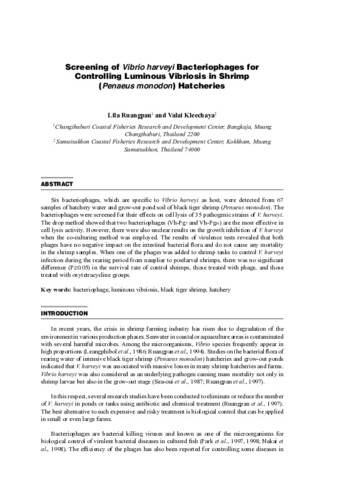Perlihatkan publikasi sederhana
Screening of Vibrio harveyi bacteriophages for controlling luminous vibriosis in shrimp (Penaeus monodon) hatcheries
| dc.contributor.author | Ruangpan, Lila | |
| dc.contributor.author | Kleechaya, Valai | |
| dc.contributor.editor | Nagasawa, Kazuya | |
| dc.date.accessioned | 2020-07-22T02:30:42Z | |
| dc.date.available | 2020-07-22T02:30:42Z | |
| dc.date.issued | 2005-03 | |
| dc.identifier.citation | Ruangpan, L., & Kleechaya, V. (2005). Screening of Vibrio harveyi bacteriophages for controlling luminous vibriosis in shrimp (Penaeus monodon) hatcheries. In K. Nagasawa (Ed.), Recent Advances in Diagnosis and Prevention of Fish and Shrimp Diseases in Southeast Asia (pp. 223–228). Tigbauan, Iloilo, Philippines: Aquaculture Department, Southeast Asian Fisheries Development Center. | en |
| dc.identifier.isbn | 9718511732 | |
| dc.identifier.uri | http://hdl.handle.net/10862/5928 | |
| dc.description.abstract | Six bacteriophages, which are specific to Vibrio harveyi as host, were detected from 67 samples of hatchery water and grow-out pond soil of black tiger shrimp (Penaeus monodon). The bacteriophages were screened for their effects on cell lysis of 35 pathogenic strains of V. harveyi. The drop method showed that two bacteriophages (Vh-Pg7 and Vh-Pg10) are the most effective in cell lysis activity. However, there were also unclear results on the growth inhibition of V. harveyi when the co-culturing method was employed. The results of virulence tests revealed that both phages have no negative impact on the intestinal bacterial flora and do not cause any mortality in the shrimp samples. When one of the phages was added to shrimp tanks to control V. harveyi infection during the rearing period from naupliar to postlarval shrimps, there was no significant difference (P≥0.05) in the survival rate of control shrimps, those treated with phage, and those treated with oxytetracycline groups. | en |
| dc.language.iso | en | en |
| dc.publisher | Aquaculture Department, Southeast Asian Fisheries Development Center | en |
| dc.subject | Penaeus monodon | en |
| dc.subject | isolation | en |
| dc.subject | oxytetracycline | en |
| dc.title | Screening of Vibrio harveyi bacteriophages for controlling luminous vibriosis in shrimp (Penaeus monodon) hatcheries | en |
| dc.type | Book chapter | en |
| dc.citation.spage | 223 | en |
| dc.citation.epage | 228 | en |
| dc.citation.bookTitle | Recent Advances in Diagnosis and Prevention of Fish and Shrimp Diseases in Southeast Asia | en |
| dc.subject.asfa | bacteriophages | en |
| dc.subject.asfa | hatcheries | en |
| dc.subject.asfa | vibriosis | en |
| dc.subject.asfa | shrimp culture | en |
| dc.subject.asfa | phages | en |
| dc.subject.asfa | intestines | en |
| dc.subject.asfa | Bacteria | en |
| dc.subject.asfa | survival | en |
| dc.subject.scientificName | Penaeus monodon | en |
| dc.subject.scientificName | Vibrio harveyi | en |
Files in this item
Publikasi ini ada di koleksi berikut
-
Recent Advances in Diagnosis and Prevention of Fish and Shrimp Diseases in Southeast Asia [43]
Terminal Report of the Regional Fish Disease Project on “Development of Fish Disease Inspection Methodologies for Artificially-Bred Seeds” Funded by the Government of Japan Trust Fund from 2000 to 2004


 AQD Access only
AQD Access only



